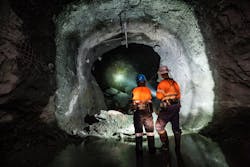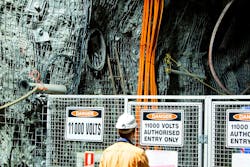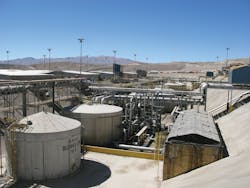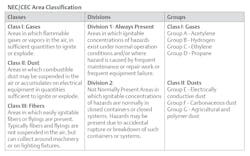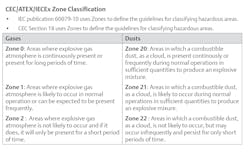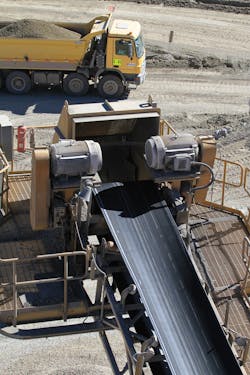Ensuring Electrical Reliability and Safety in Mining Operations
The $925-billion mining industry plays a vital role in global economic growth and development, according to research from Statista. To do so, it relies heavily upon electrical equipment as the backbone of operations. Yet no industry is harder on electrical equipment. Costly downtime, frequent maintenance, and accidents underscore the importance of specifying electrical equipment designed and engineered to perform without fail in mining’s extreme environments.
This article addresses the importance of reliable, durable, and safe electrical equipment in day-to-day mining operations. Mining operators need to leverage the experience and innovation of electrical manufacturers to drive safer, smarter, and more profitable mining — whether the operation is below ground, above ground, or in a mineral processing facility. Without reliable electrical solutions, any mining operation comes to a standstill. Electrical lighting, fittings, controls, enclosures, plugs, receptacles, and distribution equipment must perform flawlessly — no matter what the conditions may be.
A historically challenging industry
Mining has changed significantly since the 19th century when simple manual tools were utilized, and underground workers relied on caged canaries as an early warning device for toxicities in the air. However, despite numerous technology innovations and stringent safety regulations, the mining process remains extremely demanding — both on workers and electrical equipment.
Mining is notorious for its occupational risks, ranging from cave-ins and explosions to exposure to toxic air/coal dust to blasting accidents and run-ins with moving machinery. The environment also punishes the electrical equipment mining companies rely upon to keep their operations up and running. At every stage in the mining process, electrical equipment is subjected to corrosive liquids, combustible dusts, grime, harsh chemicals, heavy vibration, power surges, and extreme temperatures — all while running around the clock. If not properly engineered and diligently maintained, electrical equipment will fail, leading to costly production downtime.
Equipment reliability problems, employee safety incidents, and unplanned downtime are serious threats to the profitability of every mining operation. And they only add to the existing pressure to mine and process greater amounts of coal, metals, stone, and other commodities — even as minerals become increasingly difficult to recover and equipment, energy, and labor costs rise.
Electrical dangers
Modern mining would not be possible without electricity. Electrically powered equipment transports needed supplies, crushes and grinds rock, hauls raw materials, lights dark caverns, runs pumps and ventilation fans, and powers drills, cutting machines, dust collectors, and hoists. Despite its vast utility, electrical power in a mine can also be extremely dangerous. The U.S. Bureau of Labor Statistics reports that mining has an electrical fatality rate eight to 12 times that of other U.S. industries. Mine Safety and Health Administration (MSHA) data shows one fatality for every 22 electrical-related injuries, compared with an average of one fatality for every 203 injuries for all other injury types. For more information, read “Managing Electrical Safety in Mines” by Greg Knowles.
Water is an ongoing danger with electrical equipment in a mine. Whether it’s dredging, process water, dewatering and drainage systems, tailings ponds, or weather exposure, virtually every mining enterprise needs to operate electrical equipment in damp and wet locations. Since water and electricity don’t mix, these locations require special attention to ensure safety as well as long-lasting serviceability.
Ignitable dust and gases pose a far greater danger. Even a small spark from an electrical lamp can ignite gas or swirling dust, setting off a chain of events that can lead to an explosion. Explosions can be triggered by everything from ventilation systems failing and poor rock dusting practices to basic human error. Underground mining is inherently more susceptible to gas or dust explosions than strip, mountaintop, open pit, or other types of surface mining, although explosions do occur above ground.
Underground coal mining is particularly exposed to the dangers of methane gas and dust. Potentially explosive atmospheres can be found deep in caverns, continuous mining sections, coal crushing and screening operations, vehicle fueling stations, and many other locations in the mine. When a mixture of methane and air — also known as firedamp — in a coal mine explodes, the explosion can lead to the raising and burning of a coal dust cloud, which, in turn, produces a far more violent dust explosion. A tragic example of such a blast occurred on April 5, 2010, when a massive coal dust explosion at a West Virginia mine killed 29 miners. It was the largest mine disaster in the United States in 40 years.
Explosionproof equipment
Improperly designed electrical equipment will ignite gases and dust, leading to both explosions and the subsequent collapse of mining structures. Due to this ever-present danger, certain areas of the mine are required to install explosionproof electrical equipment. These products are designed to withstand an internal explosion that can occur when enclosed devices produce arcs/sparks or generate heat that, in turn, ignite any gases or vapors trapped within the apparatus. Explosionproof equipment incorporates a flame path that allows hot gases or vapors to safely cool before escaping into the surrounding atmosphere.
Analysis of explosionproof equipment requirements in a new mine must be performed at every phase — from basic engineering to commissioning. Updating hazardous area drawings is also required each time modifications or expansions are made to a mine. This is not the duty of a single engineer, but a multi-disciplinary job performed by several trained professionals familiar with a mine’s processes, equipment, and operations. Given the dangerous nature of mining, analysis of equipment requirements and area classifications is a highly complex exercise that requires knowledge of local regulations, applicable standards, electrical codes, company specifications, and general industry benchmarking.
To achieve certification from the U.S. MSHA, all designs and specifications for electrical equipment and accessories must be submitted for approval. Electrical equipment will be regularly inspected once it is installed to ensure it is being maintained in accordance with the Federal Mine Safety and Health Act of 1977 (Mine Act), as amended, and MSHA’s standards. For more information, visit the MSHA website.
Electrical safety requirements
Ensuring electrical equipment meets the highest local and international safety standards/certifications for harsh and hazardous locations is paramount to keeping your workforce safe. Specifying the correct electrical equipment for a mine also improves productivity and reduces operating costs.
Most countries have mining laws and regulations that address electrical safety issues. These standards apply to all electrical equipment in and around the mine, running the gamut from protective gear and communication devices to heavy-duty motors and lighting to switchboards and instrument controls.
Article 500 of the National Electrical Code (NEC) establishes the basis for classifying locations where fire or explosion hazards can exist due to flammable gases, flammable liquid–produced vapors, combustible liquid–produced vapors, combustible dusts, or ignitable fibers and flyings. Explosive liquids are rare in mines other than in and around fueling stations. As highlighted previously, the most common dangers in mines are dust and gases.
Article 500 requires the installation of Code-compliant equipment that has been tested and approved for specific hazards. Depending on the level of threat, hazardous or “classified” locations are categorized by the NEC in terms of Classes, Divisions, or Zones, and into Groups depending on the nature of the hazardous substance. Those substances may be grouped (Group A, B, C, or D) according to the ignition temperature of the substance, its explosion pressure, and other flammable characteristics (see Table 1).
Under International Electrotechnical Commission (IEC) practices, each hazardous location is typically identified by a Zone designation. IEC Zones are defined by the relative risk of the atmosphere becoming explosive. Zones 0, 1, and 2 cover the frequency of exposure within the area to explosive gases — 0 being the most continuous and 2 being the least likely. Likewise, Zones 20, 21, and 22 cover the frequency of exposure within the area to combustible dusts.
The IECEx system is the international version of the IEC standards for hazardous locations and is currently accepted in several countries. You should also be aware of the ATmospheres EXplosibles (ATEX) directive that consists of two European Union (EU) directives that address minimum safety requirements for both equipment and the workspace within an environment, which has been identified as having a potentially explosive atmosphere. The original Directive 94/9/EC dictated specific safety requirements for manufacturers of equipment intended for installation in potentially explosive atmospheres. Directive 2014/34/UE replaced 94/9/EC and updated/expanded the declaration of conformities and examination certificates equipment is required to have, in addition to improved product markings for better traceability and manufacturer identification (see Table 2).
Cost of unplanned downtime
Due to the adverse conditions of mining operations, electrical equipment must not only be properly certified but also well built both electrically and mechanically. If it is not, unplanned downtime is the consequence. As the mining industry continues to mature and commodity prices remain low, the negative impact of unplanned downtime on the bottom line will only increase. This is one reason a typical mine spends 35% to 50% of its annual operating budget on preventive maintenance and repairs, as reported in the article, “Exploring the Biggest Maintenance Challenges in the Mining Industry,” which ran in the July 2018 issue of Mining magazine.
Mining, metals, and other heavy industrial companies lose 23 hours per month of production time to machine failures at an average cost of $187,500 per hour. This amount can go much higher depending on the time it takes to get the equipment fixed as well as the size of the mining company and the number of machines that failed, malfunctioned, or are no longer operational. A standard mine works 24/7 throughout the year for years to decades, so even short intervals of unplanned downtime can have significant financial impacts, as is evidenced in the recent report on Automation.com, “World’s Largest Manufacturers Lose Almost $1 Trillion a Year to Machine Failures.”
The best starting point for mine operators to maximize machine uptime and availability is to specify the most reliable electrical equipment available. This is the proactive approach, focusing on avoiding issues instead of trying to repair them.
How mining equipment is damaged
Mining exposes electrical equipment to multiple environmental challenges that can bring about failures and downtime. Losses are exacerbated by the fact that critical pieces of electrical equipment often take a long time to replace. Below are the most common and costly reasons for electrical equipment to go non-functional:
- Corrosion: Mining sites expose electrical equipment to highly corrosive conditions due to the presence of corrosive liquids, corrosive and abrasive ores, high levels of humidity, and corrosive fumes/gases. Corrosion of electrical products in mining, ore processing, and refining operations can compromise safety and often leads to expensive downtime for maintenance or replacement.
- Vibration: Negative effects of vibration are prevalent throughout the industrial world, particularly in mining where heavy earth-moving equipment, blasting, and off-road vehicles are necessities. Mining equipment-induced vibration places a significant burden on electrical equipment. It will eventually damage components and loosen connections, causing downtime and, potentially, injuries to employees.
- Water: Electrical products in mines must be reliably sealed against ingress even under hose-down water pressures. They must provide appropriate safety features to protect people and equipment. And they must minimize the chance of failure due to improper installation or accidents.
- Dust: Dust is an especially destructive agent to electrical equipment. In addition to accelerating corrosion, dust acts as insulation, preventing heat from escaping. Dust can contain oils, organic materials, minerals, and chemicals, all of which can diminish equipment reliability and lifespan. Dust will accumulate inside unsealed equipment, creating problems with conductivity, moisture ingress, electrical shorts, increased arcing and carbon tracking, and, ultimately, premature failure. Worse, dust is combustible. Underground or on the surface, explosions are possible anywhere ignitable dust is present — from crushers and mills to cleaning processes and conveyors to transportation railways and more.
- Extreme temperatures: Minerals are mined all over the world. Coal mines can reach brutally cold temperatures of -45°C (-50°F) while salt mines in Ethiopia have ambient temperatures above 54°C (130°F). Both extremes can have negative effects on electrical equipment, especially heat. Excess heat in enclosures makes components work harder, shortening their lifetime. Replacing electrical components more frequently than normal will increase maintenance costs and downtime.
Final thoughts
Mining sites have multiple processes taking place in a single, broad location. Each part of the process demands unique electrical solutions to keep processes running with minimal downtime while eliminating worker accidents. The electrical equipment installed must be reliable, durable, and safe — whether the operation is below ground, above ground, or in a mineral processing facility.
It’s about safety, of course. But it’s also about productivity and profitability for mining companies under constant pressure to produce more — even as minerals become more difficult to recover and as equipment, energy, and labor costs rise out of sight. Neither electrical professionals nor end-users can afford reliability problems, safety incidents, or unplanned downtime. That’s why electrical products used in these critical applications must be designed to be the most rugged, corrosion resistant, and dependable in the world.
SIDEBAR: LED lighting in mines
Proper lighting is fundamental to the safety of underground mines — workers’ lives literally depend on it. Yet factors such as low ceilings, shadowing, low reflectivity, narrow tunnels/corridors, and explosive atmospheres make providing adequate, glare-free illumination in mines difficult. Mines have traditionally relied upon long-established light sources such as incandescent bulbs, fluorescent tubes, and high-intensity discharge (HID) lamps. Inadequate lighting poses major safety risks within mines.
Poor lighting decreases employee alertness and reaction time, leading to accidents. It also makes it nearly impossible to see dangerous obstacles or detect damage to vital equipment, further compromising safety. Worse, luminaires not engineered for hazardous underground areas like coal wash plants, reclaim tunnels, and conveyor systems where flammable gases are present, can ignite explosions. When you consider that the greatest percentage of accidents (53%) occur when employees are maintaining or repairing light bulbs or light fixtures, upgrading a mine's legacy lighting system — or designing a new facility — Light-Emitting Diode (LED) lighting solutions provide many benefits. Read “The Potential Impact of Light-Emitting Diode Lighting on Reducing Mining Injuries During Operation and Maintenance of Lighting Systems” from NIOSH for more information.
LED luminaires are a brighter, safer solution than legacy light sources. Quality LED luminaires have a longer life span — often approaching 100,000 hours (10+ years) — and provide improved visual perception. Effectively converting an operation to LED can provide a compelling return on investment (ROI) in terms of energy savings, reduced long-term maintenance and improved facility safety. However, be aware of LED retrofit lamp kits. Always check the hazardous location certifications on the kit you are planning to invest in. Installing some LED retrofit kits will void the manufacturer's certifications, turning an explosionproof or dust-ignitionproof luminaire, into an ordinary location one.
Adding dimming functionality to the lighting system will increase luminaire lifetime and energy savings. Greenhouse gas emissions associated with LED luminaires are considerably lower than legacy lighting sources. Upgrading to LED lighting will enhance the energy efficiency of your mine by up to 60 percent, increase employee productivity and comfort, lower maintenance costs, and improve safety by reducing injuries, fatalities, and other health hazards.
LED lighting is the most eco-friendly lighting technology available today, both in terms of energy efficiency and in controlling light pollution. Minimizing light pollution is a major deciding factor for many mining operations, especially in South America where there is a high concentration of copper mines. For instance, Chile has very strict light pollution standards (DS43) requiring warmer color temperatures and extreme shielding to eliminate uplight. Unlike incandescent, HID, or fluorescent lighting, LED lighting is highly focused, so it reduces the unwanted scattered light in the environment. Light only goes where it is needed with no waste. Look for manufacturers that offer Dark Sky Friendly luminaires, approved by the International Dark Sky Association, to reduce light trespass and skyglow. Typically, accessories can be added to a luminaire to minimize light pollution in certain mounting configurations.
About the Author
Michael Benvenuto
Michael Benvenuto is a seasoned lighting & controls specialist based in the picturesque landscape of New Mexico. A University of Connecticut graduate with a career spanning more than 15 years in the lighting industry, Michael brings a wealth of experience and expertise to the table, including 12 years at the forefront of illuminating solutions in the New York City specification market. Michael has been an integral part of Emerson’s Appleton team for the past two years. Michael is a certified MSHA Part 48 professional, dedicated to maintaining the highest standards of safety in his work, translating his knowledge to solving everyday problems in the metals & mining space.
Frank Cunningham
Product Marketing Manager for Electrical & Lighting Solutions
Frank Cunningham is a senior product marketing manager with Emerson’s Appleton Lighting team. He helps develop new industrial LED lighting solutions by applying more than 16 years of electrical industry experience in technical support and inside sales roles along with field experience as a journeyman electrician. He is based at the Appleton headquarters in Rosemont, Ill.
